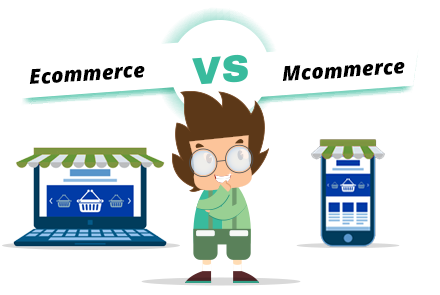How to Start a Successful Business? Mcommerce vs eCommerce
LAST UPDATE: NOV 13, 2022
Considering that e-commerce and the new related expression m-commerce have many implications the two expressions try to simplify clients’ life e-commerce is the general word for trading on the web while mobile commerce is a subset of online commerce that spotlights a cellphone as a tool that is used to buys regardless of having a comparable web-based buying and selling targets there are various recognizable differentiations among m-commerce and eCommerce business
What is eCommerce?
Electronic trade, or eCommerce, is an idea that shows a computerized stage and a business technique that permits you to trade merchandise on the web. Each time you make a web-based buy, you add to the eCommerce business.
The idea fluctuates and is comprehensive, as it likewise includes web-based banking, programming arrangements, online organization administrators, and stages for internet learning notwithstanding Amazon and eBay (essentially, any exchange made on the web).
Albeit the expression “Internet business” is as often as possible used to portray the standard web-based shop offering shirts to end clients, because of the conditions.
Michael Aldrich laid the foundation for web-based shopping in 1979. He utilized his telephone association to connect his TV to a PC. Although it wasn’t eCommerce as far as we might be concerned today, his idea led to the idea of shopping on the web as opposed to going to an open store. Most people at the time didn’t possess computers. Steve Jobs and Bill Gates made PCs open to the overall population. Significantly more, Bill Gates expressed that he needed “a PC in each work area and each home.” eCommerce would be different without PCs, by 2023, eMarketer predicts that web-based retail deals will add up to $6.17 trillion, with eCommerce sites representing 22.3% of all retail sales.
Types of eCommerce
An eCommerce organization could decide to run in various ways, contingent upon its items, administrations, and hierarchical construction. The following are a couple of the most popular organization models.
1- Business to Consumer (B2C).
B2C eCommerce organizations market their items straightforwardly to buyers. A business-to-buyer (B2C) association conducts business straightforwardly with the purchaser who will use the item in the end as opposed to conveying things to a middle person, business-to-customer eCommerce organization can markets skincare products straightforwardly to shoppers. To urge their objective segment to purchase their things for individual use.
2- Direct to the Customer (D2C).
Impressive business (D2C) brands are those that make items as well as offer them to clients, removing agents between the brand and the last purchaser.
Significantly, these organizations can speak with and structure bonds with the clients who utilize their items, grow a group of people, and further develop conveyances.
To sell your image as opposed to proceeding to utilize specialists or Amazon
By making your image and controlling the appropriation of your thing, you might sell straightforwardly to the clients they were initially attempting to serve.
Yet, for this sort of eCommerce, an unmistakable brand is required, and no mediator might have gotten everything done well.
3- Business to Business (B2B).
The two sides are organizations in the B2B model. Typically, an item or administration is traded between two organizations.
B2B organizations are normally administration or programming-based firms (here and there known as “offices” or “SaaS”). Item selling B2B organizations do exist and are contingent upon where they are in the worth chain, they are oftentimes providers or makers offering to wholesalers or retailers.
4- Consumer to Business (C2B).
Present-day stages have simplified it for clients to connect with organizations and offer their types of assistance, especially concerning brief positions or independent positions. Contemplate the postings on Upwork, for example. Clients can speak with organizations searching for specific specialists or solicitation quotes from them. The eCommerce stage joins organizations with self-employed entities in this manner to give clients more command over addressing their necessities concerning cost, planning, and work.
5- Consumer to Government (C2G).
Through C2G coordinated efforts, clients can speak with legislatures, associations, or states in a less normal eCommerce way. These organizations now and again include a commitment-based exchange as opposed to the trade of administrations.
6- Customer to Consumer (C2C).
Laid-out organizations that sell merchandise straightforwardly to shoppers (C2C) are the main elements that can do as such. Advanced commercial centers, an illustration of an eCommerce stage, interface clients with different clients who can list their items and complete their deals. These C2C stages may be postings as sales or they could call for more discussion about the great or administration being advertised. C2C eCommerce stages, made conceivable by innovation, empower customers to trade without the help of organizations.
What is M-commerce?
Versatile trade, or m-commerce, is the act of leading business web-based using remote cell phones, like cellphones and tablets, for things like trading products, coordinating stores, and covering bills.
The utilization of m-commerce is extending. m-commerce companies Retail deals in the United States outperformed 360 billion bucks in 2021, claims statistical surveying firm Statista. That worth is expected to increment to just about 710 billion US dollars by 2025, almost multiplying.
Clients of m-commerce can carry on with work anyplace for however long there is a remote internet service present.
As security concerns have been tended to, m-commerce companies have quickly risen.
m-commerce companies are a developing subset of this model. As per the Pew Research Center, around 97% of Americans have a cellphone, and 85 percent of those have a cell phone, up from 35% in 2011.
Mcommerce companies help look for a large number of labor and products, including banking, effective financial planning, and the purchasing of computerized music, books, and carrier tickets. Various factors, for example, working on remote convenient gadgets, an overflow of m-commerce organizations applications, and the far and wide goal of safety issues, have added to the quick development of m-commerce business.
As you’ve seen, the expression “m-commerce” covers a large number of exercises, from mobile financial services to mobile payments and shopping.
How About We Inspect the Different Types of Mcommerce Organizations:
1- Shopping on Mobile.
The comfort of shopping is brought to the client straightforwardly on their cell phone by the mobile business. The intriguing thing about this is the number of various structures m-commerce can take. On cell phones, clients can make buys through an internet browser, a web application, or a local mobile application.
2- Mobile Financial
The interest in mobile banking is developing as customary monetary administrations suppliers face expanded rivalry from fintech new companies.
Various small eCommerce businesses currently focus on making a client-driven encounter. To this end, they go to mobile banking, where the objective is to furnish clients with banking services and items through safe mobile applications.
3- Utilizing a mobile wallet.
Since it permits clients to purchase things utilizing a cell phone and lessens exchange contact, this subcategory of m-commerce is firmly connected with the other two. electronic wallets, similar to Apple Pay or Google Pay, are amazing instances of mobile payments. Clients can buy products from them without swiping a card, pay with money, or even enter their Visa data into the application.




Recent Comments